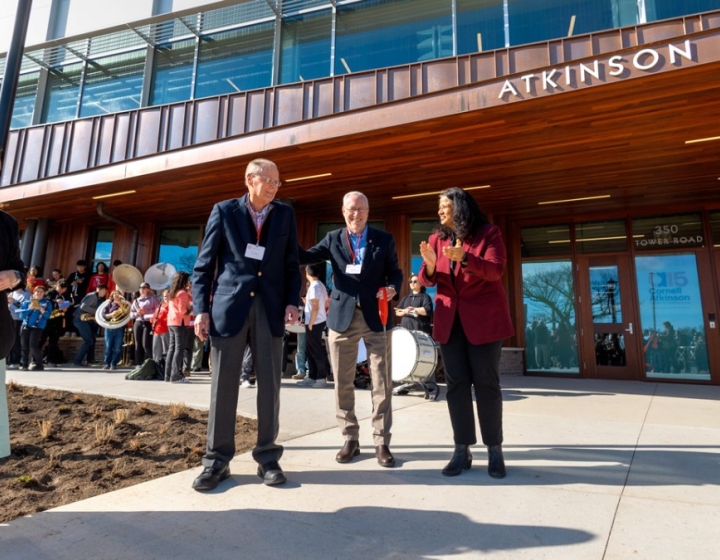Tiny but mighty: babies use their immune system differently but efficiently
It was long believed that a newborn’s immune system was an immature version of an adult’s; now, researchers show that newborns instead use their T cells differently than adults. These results help clarify why adults and infants respond differently to infections, and pave the way for controlling T cells’ behavior for therapeutic applications.
This discovery, made by Dr. Brian Rudd, associate professor in the Department of Microbiology and Immunology in the College of Veterinary Medicine, and Andrew Grimson, professor in the Department of Molecular Biology and Genetics in the College of Arts and Sciences, was recently published in the journal Science Immunology.
“The immune system is almost always viewed from an adult perspective,” says Rudd. He explains that researchers often compare the performance of neonatal and adult T cells to functions that adult immune cells do very well. For example, adult T cells outperform newborn T cells at tasks like recognizing antigens, forming immunological memory and responding to repeat infections, which has led to the belief that infant’s T cells were just a weaker version of the adult ones.
However, Rudd says, scientists are starting to appreciate that immune cells in early life behave completely different than those in adulthood. In the recent pandemic, the apparent lack of illness in infants came as a real surprise to many, bringing into question the long-standing belief that the infant immune system is simply an immature version of the adult one.
Interested in understanding these age-related differences, Rudd and Grimson discovered that newborn T cells are not deficient: instead, they are involved in a part of the immune system that does not require antigen recognition. While adults T cells use adaptive immunity — recognizing specific germs to then fight them later — newborn T cells are activated by proteins associated with innate immunity — the part of the immune system that offers rapid but non-specific protection against microbes the body has never encountered before.
“Our paper demonstrates that neonatal T cells are not impaired, they are just different than adult T cells and these differences likely reflect the type of functions that are most useful to the host at distinct stages of life,” says Rudd.
This ability of neonatal T cells to participate in the innate arm of the immune system enables newborn’s T cells to do something that most adult T cells cannot: respond during very first stages of an infection and defend against a wide variety of unknown bacteria, parasites and viruses.
“We know that neonatal T cells don’t protect as well as adult T cells against repeat infections with the same pathogen. But neonatal T cells actually have an enhanced ability to protect the host against early stages of an initial infection,” says Rudd. “So, it is not possible to say adult T cells are better than neonatal T cells or neonatal T cells are better than adult T cells. They just have different functions.”
Interestingly, the team also found that these innate neonatal T cells persist into adulthood in both mice and humans and play unique roles during infection. The team believes that in adults, these neonatal T cells may respond to inflammation that occurs during an infection, in cancer and in autoimmune diseases.
As part of their research, Rudd and his collaborators identified the molecular mechanisms that allow T cells to respond to inflammation and switch between innate and adaptive functions. “We now know the key epigenetic and transcriptional programs that distinguish neonatal T cells from adult T cells at the individual cell level,” says Rudd. This knowledge is essential to develop medical applications for controlling T cells behavior in specific ways.
For Rudd and Grimson, a real game changer has been the technology that is now available to study gene regulation of immune cells at the single-cell level. It allowed them to provide “new insight into a poorly understood biological process at a very in-depth level.”
“Being able to go from observing unique function of T cells to a molecular mechanism is really exciting,” says Rudd. “And this was possible because we were able to combine the expertise in cellular and developmental immunology in my lab with the tools to study gene regulation in Andrew’s lab.” A large, multi-institution project, the study also included collaborators at University of Rochester and University of Washington.
Following up on his discovery, Rudd wants to study the neonatal T cells that persist into adulthood in humans. “We are also interested in studying how changes in the relative numbers of neonatal T cells in adults contributes to variation in the susceptibility to infection and outcomes to disease.”
This work was supported by the National Institute of Allergy and Infectious Disease and the National Institute of Child Health and Human Development, in the National Institutes of Health.
A modified version of this story appears in the Cornell Chronicle.
Written by Elodie Smith






